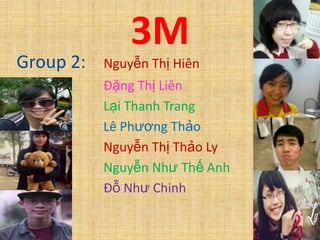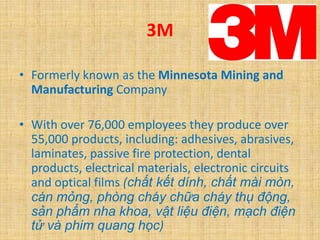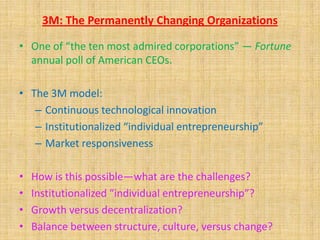3 M Company Case Study
- 1. Group 2: 3M Nguyáŧ n Tháŧ HiÊn Äáš·ng Tháŧ LiÊn Lᚥi Thanh Trang LÊ PhÆ°ÆĄng ThášĢo Nguyáŧ n Tháŧ ThášĢo Ly Nguyáŧ n NhÆ° Thášŋ Anh Äáŧ NhÆ° Chinh
- 4. Outline âĒ Introduction âĒ Innovation in 3M âĒ Conclusion
- 6. 3M âĒ Formerly known as the Minnesota Mining and Manufacturing Company âĒ With over 76,000 employees they produce over 55,000 products, including: adhesives, abrasives, laminates, passive fire protection, dental products, electrical materials, electronic circuits and optical films (chášĨt kášŋt dÃnh, chášĨt mà i mÃēn, cÃĄn máŧng, phÃēng chÃĄy cháŧŊa chÃĄy tháŧĨ Äáŧng, sášĢn phášĐm nha khoa, vášt liáŧu Äiáŧn, mᚥch Äiáŧn táŧ và phim quang háŧc)
- 7. 3M: A brief history âĒ Established in 1902, producing abrasives and adhesives products. â Benefited from product innovation in the early days â The culture of âindividual entrepreneurshipâ âĒ The McKnight era, 1929-1966 â Organizational design for continuous changes âĒ The Lou Lehr era, 1980-1985 â Reorganization and reorientation âĒ The âJakeâ Jacobson era: 1986-1991 â The orientation to competition in existing markets âĒ Main characteristics: â Changes and evolution in adaptation to environments â Changes in organizational attributes for innovation
- 8. 3M: The Permanently Changing Organizations âĒ One of âthe ten most admired corporationsâ â Fortune annual poll of American CEOs. âĒ The 3M model: â Continuous technological innovation â Institutionalized âindividual entrepreneurshipâ â Market responsiveness âĒ âĒ âĒ âĒ How is this possibleâwhat are the challenges? Institutionalized âindividual entrepreneurshipâ? Growth versus decentralization? Balance between structure, culture, versus change?
- 9. Innovative Culture in 3M âĒ 3Mâs culture fosters an environment of innovation Innovation of culture in 3M: - Give people time to follow their dream. - Make it a part of the expertâs job to share their knowledge. - Result must be measured. - Be honest and know when to say no. - Promote a career not a job. - Internationalize your management team. - Keep spending on research and development.
- 10. âĒ Vietnamese Honda motor company Respect the ideas of the employers as well as employees Create a friendly and active working environment
- 11. INNOVATION MANAGEMENT Building a innovative organization
- 12. âĒ âĒ âĒ âĒ âĒ âĒ âĒ âĒ Recognition & reward Reinforcement of core values Sustaining âcirculationâ Allocating slackâ & permission to play Patience Acceptance of mistakes & encouragement of risk-taking Encourage âbootleggingâ Policy of hiring innovators
- 13. Recognition & reward âĒ Schemes to acknowledge innovative activities âĒ Recognizes effort > achievements
- 14. Reinforcement of core values âInnovation is respectedâ
- 15. Sustaining âcirculationâ âĒ Different people + Different perspectives = creative combinations
- 16. Allocating âslackâ & permission to play âĒ Curiosity-driven activities
- 17. Patience âĒ Acceptance of the need for âstumbling in motionâ as innovative ideas evolve and take shape.
- 18. Acceptance of mistakes & encouragement of risk-taking âĒ âMistakes will be made, but if a person is essentially right, the mistakes he or she makes are not as serious, in the long run, as the mistakes management will make if itâs dictatorial and undertakes to tell those under its authority exactly how they must do their jobâĶâ
- 19. Encourage âbootleggingâ Giving employees a sense of empowerment and turning a blind eye to creative ways => get around the system acts
- 20. Policy of hiring innovators looking for people with innovator tendencies and characteristics âĒ âĒ âĒ âĒ âĒ An opportunistic mindset Formal education or training Proactivity and a high degree of persistence A healthy dose of prudence Social capital
- 21. May Saigon 2 Company
- 22. VNU-UEB
- 23. Eurowindow
- 24. Innovation in organization structure 3M used to be organic structure, which links people in different functions into a coherent. 3M divided most employees network into at least five levels: department, division, group, sector and company What is organic structure? Its advantage & disadvantage?
- 25. What is organic structure the organization has characteristic: Flatness: communication & interaction are horizontal Low specialization: knowledge resides wherever it is most useful Decentralization: great deal of formal and informal participation in decision making
- 26. âĒ They have a flexible approach to the continually changing financial and customer environment. âĒ They can be very responsive and quick to make changes âĒ Staff structures are also very fluid, with wide ranging job descriptions âĒ They cope better with unstable environments âĒ The employees are very much involved in decision making and problem solving; this enhances motivation, commitment and gives a variety of perspectives âĒ The ease of ability or change enables organic organizations to be more creative and imaginative
- 27. Disadvantage âĒ âĒ âĒ âĒ No Boundaries Unproductive Directives: Ineffective Leadership Communication Barriers
- 28. Case in Viet nam
- 29. Process *Develop: - Structure - Policies Guide innovative activity: picking up signals through implementation *Parallel routes through their system Innovations can come from many ways: - Market interactions - Deep technology research - collaboration - unexpected discovery *Association skill: Technical knowledge â awareness of real / latent market needs => creative combination
- 30. âĒ System for innovation & extensions: *1st : formal stage-gate (a trial by fire), based on established products Well-known but need encouraging innovation champions to take non-linear ideas *2nd : incubator stage: o ideas are encouraged & development funds are available o reject loose targets o strict business plan appraisal for projects => funnels and clear gateway
- 31. Honda Viet Nam âĒ Manufacturing Process: 2nd system - Event / Competition: o employees speak out their ideas at any time o prize for the valuable contribution. - The good idea will apply to the process - Implementing R&D from fortunate discovery by their staff
- 32. Innovation Strategy and Leadership - CEOs have been strongly associated with enacting and supporting the innovation culture which characterizes the firm - The overall innovation strategy is focused on two core themes â deep technological competence and strong product development capabilities
- 33. Innovation Strategy âĒ Setting stretch targets, a focus for the whole Organization. âĒ Allocating space and time for staff to explore ideas. âĒ Encouragement employees working on innovation projects in their own time and often accessing resources in a non-formal way âĒ Encourages âintrapreneurshipâ (internal entrepreneurial behaviour) rather than people feeling they have to leave the firm to take their good ideas forward.
- 34. Innovation Strategy and Leadership in Vietnam âĒ CEOs should take time to understand the potential of their employees and the prospect of their organization. âĒ Encourage and incentive with new ideas which have good outcome or improvement.


































